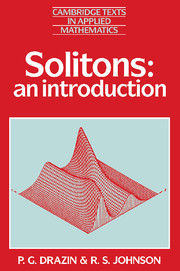Book contents
- Frontmatter
- Contents
- Preface
- 1 The Korteweg–de Vries equation
- 2 Elementary solutions of the Korteweg–de Vries equation
- 3 The scattering and inverse scattering problems
- 4 The initial-value problem for the Korteweg–de Vries equation
- 5 Further properties of the Korteweg–de Vries equation
- 6 More general inverse methods
- 7 The Painlevé property, perturbations and numerical methods
- 8 Epilogue
- Answers and hints
- Bibliography and author index
- Motion picture index
- Subject index
- Frontmatter
- Contents
- Preface
- 1 The Korteweg–de Vries equation
- 2 Elementary solutions of the Korteweg–de Vries equation
- 3 The scattering and inverse scattering problems
- 4 The initial-value problem for the Korteweg–de Vries equation
- 5 Further properties of the Korteweg–de Vries equation
- 6 More general inverse methods
- 7 The Painlevé property, perturbations and numerical methods
- 8 Epilogue
- Answers and hints
- Bibliography and author index
- Motion picture index
- Subject index
Summary
The theory of solitons is attractive and exciting; it brings together many branches of mathematics, some of which touch on deep ideas. Several of its aspects are amazing and beautiful; we shall present some of them in this book. The theory is, nevertheless, related to even more areas of mathematics, and has even more applications to the physical sciences, than the number which are included here. It has an interesting history and a promising future. Indeed, the work of Kruskal and his associates which gave us the ‘inverse scattering transform’ – a grand title for soliton theory – is a major achievement of twentieth-century mathematics. Their work was stimulated by a physical problem together with some surprising computational results. This is a classic example of how numerical results lead to the development of new mathematics, just as observational and experimental results have done since the time of Archimedes.
This book has grown out of Solitons written by one of us (PGD). That book originated from lectures given to final-year mathematics honours students at the University of Bristol. Much of the material in this version has also been used as the basis for an introductory course on inverse scattering theory given to MSc students at the University of Newcastle upon Tyne. In both courses the aim was to present the essence of inverse scattering clearly, rather than to develop the theory rigorously and completely. That is also the overall aim of this book.
- Type
- Chapter
- Information
- SolitonsAn Introduction, pp. xi - xiiPublisher: Cambridge University PressPrint publication year: 1989



